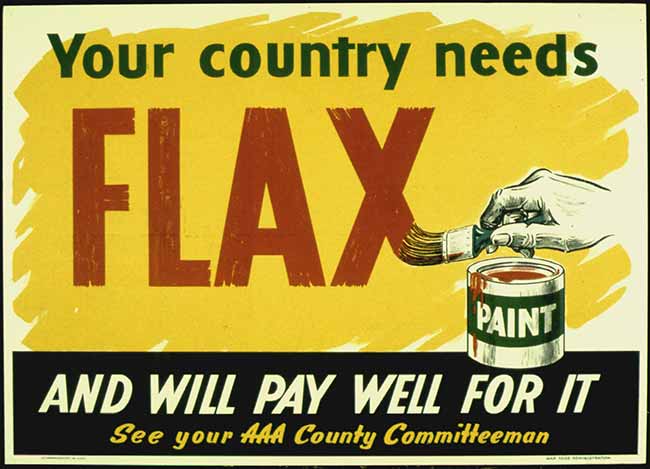Flax Is Not a Health Food — Stop Consuming It and Use It to Paint Instead – Dr Mercola
Tue 11:14 am +00:00, 4 Jun 2024 9- June 04, 2024
STORY AT-A-GLANCE
- Flax, historically used in paints and industrial applications, is often marketed as a health food despite its potential negative effects on metabolism and long-term health
- The principal use of flax oil in the past has been for industrial purposes, such as paint, due to its high polyunsaturated fat (PUFA) content, which makes it prone to oxidation
- Consuming flaxseed oil, synonymous with linseed oil, can be harmful because PUFAs are unstable and oxidize easily
- Flaxseeds also contain lignans, a type of phytoestrogen, which can mimic estrogen and contribute to hormonal imbalances, increasing the risk of conditions like breast cancer
- Excess PUFA consumption lowers thyroid and metabolism, as thyroid hormone (the master metabolic regulator) is blocked at the production, transport, and cellular action steps by PUFA
When evaluating something as a ‘health food’ — we have to put our ‘metabolism lenses’ on. Does this improve metabolism and thus long-term health? Or, are there potentially some minute short-term benefits that come with long-term consequences and a down-regulation of metabolism? (Which will negatively impact health.)
There is really good marketing out there trying to convince us that ingredients historically used as paint are now a superfood. (Because it is extremely profitable!) One example is flaxseed and flaxseed oil — you should not be consuming these! And to better understand why, let’s briefly review why it works really well for paint!
The principal use of the oil in flax in the past has been in paints, coating and other industrial uses — the fibers were used to make fishing nets, ropes, and sailcloths and the linseed oil obtained from the flax plant has been one of the most important binders for oil paint for more than 500 years.
Flax is rich in an omega-3 polyunsaturated fat (PUFA) alpha-linoleic, C18:3. PUFAs contain 2 or more double bonds (shown in green, below), and each double bond in the fat makes it more unstable and prone to oxidation.

The structures of a saturated, monounsaturated, and polyunsaturated fat. Note the differences in points of unsaturation (C=C double bonds) on some of the fatty acids. From Nutrition: Science and Everyday Application, v. 1.0.
The longer the chains of these PUFA get (such as ALA), the more unsaturated and unstable they become.
How Flaxseed Went From Paint to ‘Health Food’

Flaxseed oil or flax oil is technically synonymous with the term ‘linseed oil,’ as both refer to the oil obtained from the dried, ripened seeds of the flax plant. The oil is obtained by pressing, sometimes involving a lot of chemicals for more industrial uses. Some refer to the ‘edible’ oil as flaxseed oil, and the industrial use as linseed oil. But the fatty acid composition of flaxseed oil or linseed oil (used interchangeably) are both PUFA rich.
Linseed oil works well as a paint due to its high level of PUFAs — all of those double bonds make them extremely prone to oxidation. In fact, linseed oil is classified as a “drying oil,” meaning it transitions from a liquid to a solid film through oxidative reactions.
“When this flax oil is exposed to air, the double bonds of ALA react with oxygen and result in relatively soft, durable film. This property is known as ‘drying’ quality of linseed oil.”1



However, newer petroleum products started to enter the market in place of linseed oil since they could be made cheaper, and this led to the reduced reliance on flax.2 So, the flax industry needed to find another market for it — enter the health food market and lots of marketing!

“50 years ago, paints and varnishes were made of soy oil, safflower oil, and linseed (flax seed) oil. Then chemists learned how to make paint from petroleum, which was much cheaper. As a result, the huge seed oil industry found its crop increasingly hard to sell.
Around the same time, farmers were experimenting with poisons to make their pigs get fatter with less food, and they discovered that corn and soy beans served the purpose, in a legal way.
The crops that had been grown for the paint industry came to be used for animal food. Then these foods that made animals get fat cheaply came to be promoted as foods for humans, but they had to direct attention away from the fact that they are very fattening. The ‘cholesterol’ focus was just one of the marketing tools used by the oil industry.
Unfortunately it [the false claims about cholesterol & saturated fat] is the one that has lasted the longest, even after the unsaturated oils were proven to cause heart disease as well as cancer.” ~ Dr. Ray Peat
Flax Is High in Estrogenic Compounds Too
Have you ever noticed that flax oils can only be purchased in dark containers, and must be stored in the fridge? (They oxidize in the presence of heat and oxygen). Can you imagine what happens when you consume this and put it in your warm, oxygen-rich body? (The inside of our body should be 98.6 deg F.) And yes, flax contains some fiber but still has a lot of PUFAs.
• Per 100 grams:
◦ The oil extracted out of flax contains 100 grams of fat with 14.3 grams of linoleic acid and 53.4 grams of ALA.
◦ Whole flax contains less fat (42.4 grams) since there is fiber, but still 5.9 grams linoleic acid and 22.8 grams ALA.
You can get these fibers in from other foods without all this PUFA. But there are other negative health consequences outside of the high susceptibility to oxidation. Flaxseeds contain a type of phytoestrogen called lignans. Phytoestrogens act like estrogen in the body (and we do not need more estrogen in modern times). “[L]ignans that are structurally similar to known estrogenic compounds.”3
Another example of a well-known phytoestrogen is isoflavones in soy. Well, flax is 20 times stronger than soy when it comes to the estrogenic impact!
Dr. Hobbins is a former surgeon who pioneered breast cancer detection through mammography and thermography. Dr. Hobbins and Wendy Sellers have hundreds of thermogram images showing striking visual evidence that estrogenic foods (including flax) promote vascularization and angiogenesis in the breast tissue, increasing the risk of breast cancer.4
Misinformed health care workers and manipulated studies are promoting these phytoestrogenic foods as cancer-preventing — when instead they could be making matters worse!
Add on top of this that the accumulation of PUFAs in tissues promotes the action of estrogen by activating aromatase AND people with lower metabolic rates are pooping less and less (pooping isn’t just to get rid of food waste, it is also a way to get rid of used hormones and other toxins in the body! So not pooping every day will cause some estrogen re-absorption).

Save This Article for Later – Get the PDF Now
Are You Really Low in Estrogen?
In this estrogenic and PUFA rich world — no wonder hormonal imbalances are rampant, and testosterone is plummeting in men! Many people believe that they are LOW in estrogen due to bloodwork. Unfortunately, serum estrogen levels are NOT representative of estrogen that has been stored in tissues. Estrogen can be low in plasma, but high in tissues.5
And when stored estrogen is assessed, most people are estrogen dominant due to high PUFA diets and exposure to environmental estrogens from pesticides and plastics. And for women, add on many years of birth control loading up on exogenous estrogen! So you likely do not need more estrogenic foods (like flax).
A simple way to gauge estrogen storage in fat and tissues is a simple prolactin blood test, as prolactin blood tests can be used as a proxy for stored estrogen since estrogen promotes the production of prolactin. Ideally prolactin is less than 10 ng/mL.
Excess PUFA Lowers Thyroid Function
Another reason to not eat flax — excess PUFA consumption lowers thyroid and metabolism — as thyroid hormone (the master metabolic regulator) is blocked at the production,6 transport,7 and cellular action8 steps by PUFA.
“Fatty acids inhibited the binding of T3 to both receptor proteins (TR-alpha and TR-beta) … The effectiveness of inhibition depends on the chain length and degree of saturation of the fatty acids.”9
Further, PUFAs block proper carb metabolism more so than saturated fats10 by inhibiting the function of the PDH enzyme11,12 and cytochrome C oxidase13 — two vital components in glucose metabolism. And the negative effect on glucose metabolism increases with chain length and degree of unsaturation of the fatty acids.14 In fact, flax consumption has been shown to make you more insulin resistant and hinder carb utilization.15,16
Flax Inhibits Cholesterol Production
Another undesirable trait of flax is that it lowers endogenous production of cholesterol — which may sound good initially. But cholesterol is the building block of steroid hormones, and lowering cholesterol through estrogenic foods like flax will lower testosterone in males and progesterone in females. Plus, anything that suppresses your cholesterol synthesis increases the risk of cancer (like statins).
The best way to lower elevated cholesterol levels is to improve thyroid (which will still allow the body to make adequate androgens). Hormones are a downstream effect and should not try to be manipulated through estrogenic-rich foods. Fix metabolism and thyroid health, and hormonal balance will come easier! Instead of flax, try:
- Reducing PUFA consumption and instead prioritize saturated fats
- Lowering plastic exposure
- Consuming carbohydrates to boost thyroid and metabolism (adequate thyroid is essential for both the production of progesterone and the detoxification of estrogen by the liver)
- Supplementing with bio identical progesterone, as needed (adequate progesterone levels help keep estrogen in check)
- Ensuring adequate Vitamin B6 consumption (serves as a prolactin inhibitor)
Transform Your Health — One Step at a Time


Ashley and her sister Sarah have put together a truly groundbreaking step-by-step course called “Rooted in Resilience.” They have compiled what clearly is the best application of Dr. Ray Peat’s work on Bioenergetic Medicine that I have ever seen.
It is so good that I am using the core of their program to teach the many Health Coaches that I am in the process of training for the new Mercola Health Clinics I am opening this fall. It took these women working nearly full-time on this project for a year to create it.
This has to be one of the absolute best values for health education I have ever seen. If you want to understand why you struggle with health problems and then have a clear program on how to reverse those challenges, then this is the course for you.
It is precisely the type of program I wish I would have had access to when I got out of medical school. I fumbled around for decades before I reached the conclusion they discuss in the course and share with you so you can restore your cellular energy production and recover your health.
| Select and eat the right foods to heal your metabolism and improve glucose utilization |
| Balance your hormones to help reduce anxiety, weight gain and sleep disturbances |
| Use reverse dieting to increase your calories without gaining weight and tanking your metabolism, all while improving your energy levels |
| Heal your gut for proper immune function, mood and weight management |
| Tweak your diet and lifestyle habits to improve your mindset and mental health |
| Crush your fitness goals with ease and get your life back on track |
| Master the most essential habits for health with bonus guides, including over 100 meal plans to take the stress out of meal time planning and shopping, and so much more! |
Learn more about Rooted in Resilience here.


About the Author
Ashley Armstrong is the cofounder of Angel Acres Egg Co., which specializes in low-PUFA (polyunsaturated fat) eggs that are shipped to all 50 states (join waitlist here), and Nourish Cooperative, which ships low-PUFA pork, beef, cheese, A2 dairy and traditional sourdough to all 50 states. Waitlists will reopen shortly.














Thanks danceaway for this info. My wife and I have been using flax seeds regularly and we have now stopped thanks to you. Much appreciated
I have been using it, too, Pete, and am now horrified. Will be throwing it out!!
Me too! My flax is now in the bin
Its not only Flax seed oil Danceaway that is bad but most seed oils. I use only Coconut oil and Olive oil, Coconut oil mainly for cooking. Unlike other oils you will notice it doesn’t change colour when heated.
Good advice newensign
What about pumpkin oil? Do you know about that? I use it very sparingly as a condiment. Should I stop?
I don’t know about pumpkin oil Pete, if its liquid its likely its bad. That is, its a polyunsaturated fat. That is why animal fats such as beef and lamb also butter are good for you.
I also use only coconut oil for cooking and only olive oil for salads. I think some others such as avocado oil, as they come from oily plants are probably OK. I always buy cold pressed, organic oil.
Yes, I knew about the other seed oils, and only use coconut and olive, as well, but flax comes in other forms and is presented as healthy!! We’ve certainly been conned!
I watch Wilderness Cooking site on youtube. He uses loads of mostly lamb fat, and I mean loads. I commented to the effect that surely it’s bad for you, but was reassured that the locals all live to 100. We’ve been conned big style.